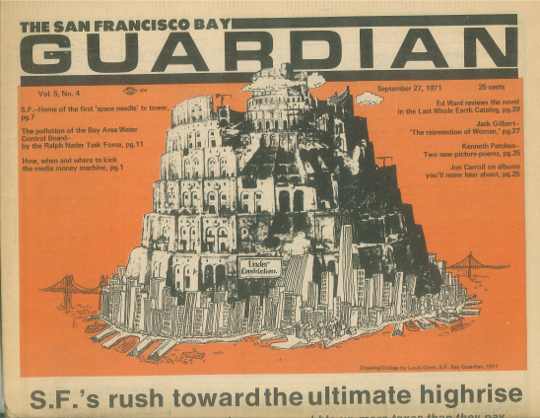“SF’s rush toward the ultimate highrise” read the headline on the Guardian front page of Sept. 27, 1971. The headline and the graphics by Art Director Louis Dunn illustrated the central point of our bombshell study: that despite the rhapsodies of the Chamber of Commerce and the big developers, highrise commercial buildings don’t produce gushing revenues and they don’t pay for themselves.In fact, our exclusive study of the downtown highrise district found that “for every $10 the district yields to the city treasury, the city has to provide $11 in services.
“Put another way: the highrise district contributes $62.9 million, or 25.2% of all locally generated municipal revenue. But it costs $67.7 million, or 25.2% of all locally financed expenditures (figures from fiscal 1970.
“This means taxpayers subsidize–35 cents or so on the tax rate in fiscal 1970–the construction and maintenance of our civic monuments–the Bank of America building, the Transamerica building, the Hilton Hotel–and soon, another 23 skyscrapers that will be taller and bulkier and more expensive than ever for residents and taxpayers.”
Project Director Tom Lehner, a San Francisco resident and expert on urban policy from UC-Berkeley’s School of Public Policy, made the crucial point: :”This report overturns once and ffor all, emphatically and conclusively, the conventional wisdom that downtown skyscrapers somehow provide the municipal treasury with its lifeblood.
“Anyone who thinks for a moment about what’s happening in New York,” Lehner added, “will come to the same conclusion as our study did. But the air’s been so full of propaganda from the Chamber of Commerce and other downtown interests like the Examiner and Chronicle that it’s difficult to have a clear thought about the subject.” The economic fact that taxpayers subsidize highrise development has become gospel and helped provide the ammunition for the slow growth movement on commercial highrises that ultimately won on the Proposition M initiative in 1986.
Below is the PDF that shows our study with the Louis Dunn drawings: scroll through.
http://test.sfbg.com/PDFs/highrise.pdf
Today, the burning issue is the luxury building at 8 Washington and the host of market rate developments already built or in the works and their impact on neighborhoods. And today the city needs a study that can provide the facts on the economic impact of market rate development and how neighborhoods can cope with the impacts in an era of “now new taxes.”
Tony Kelly is the president of the Potrero Hill Boosters and one of the most knowledgeable neighborhood activists on the market rate housing front. He and the Boosters are dealing with the Mission Bay Landrush and the city’s plan to flood the Eastern Neighborhoods with market rate housing. His take is most instructive on why a study is needed:
‘”During the Eastern Neighborhoods re-zoning in 2008, I saw neighbors who supported development turn into NIMBYs overnight as soon as they realized that building market-rate housing in San Francisco doesn’tpay for itself, or much of anything else. On Potrero Hill, we spent an entire decade working on neighborhood planning that was supposed to
give us new parks, new transit lines, and better schools in a part of town that desperately needs all of that. And then, when the new zoning was finally approved … … we found out that none of those improvements made it over the finish line.
“The impact fees for the new development won’t even come close to providing the transit, parks, schools or infrastructure that the new residents need, let alone those of us who are already here in a very underserved part of town. I shouldn’t really have to remind you that the new housing isn’t affordable for City residents. And the Planning
Department’s own study from 2008 confirms that when you build market-rate housing, you create a bigger need for affordable housing – more than you are getting in affordable housing fees or inclusionary units.
” So, with every new market rate housing unit, we are falling further behind on everything the City needs to do to support neighborhoods. And the increased property taxes are all going to the General Fund, to support services elsewhere in the City. Who in their right minds, in any neighborhood, would sign up for such a deal?
“Now, on this side of town, we are stuck with development plans that are designed to double the populations of district 10 and district 6 in the next 20 years. In my neighborhood, Potrero Hill, the population will triple. And now we have to figure out how to support this booming population without much help from City Hall.
“The new condominium projects that the Potrero Boosters Neighborhood Association has already seen in the past few months reveal the consequences of the Eastern Neighborhoods rezoning—thousands of condos and apartments (and thousands more residents) coming to the neighborhood, with very few opportunities for children or families, and not much planning from the City for alternatives to automobiles.
“We cannot have urban density in our part of this City with suburban ways of living and getting around, and yet, that is what we have, now and in the future. So in the neighborhoods, we have to plan (and takeaction) to create our own infrastructure, and not simply rely on what the City manages to give us.”
Kelly’s arguments against pellmell market rate housing is particularly strong for the city’s new frontier of Mission Bay and the Eastern Neighborhoods, but it applies to every neighborhood and the entire city. This is why for starters the supervisors need to direct the budget analyst or the city’s economist to do a detailed study to help Tony Kelly and the rest of the neighborhoods deal properly with the onslaught of market rate housing. b3
Editorial on the case against 8 Washington:
> http://www.sfbg.com/bruce/2012/03/06/editorial-case-ag

